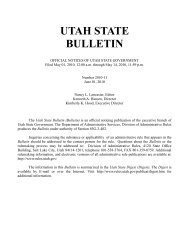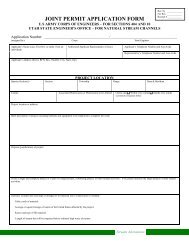Vol. 2007, No. 15 (08/01/2007) PDF - Administrative Rules - Utah.gov
Vol. 2007, No. 15 (08/01/2007) PDF - Administrative Rules - Utah.gov
Vol. 2007, No. 15 (08/01/2007) PDF - Administrative Rules - Utah.gov
You also want an ePaper? Increase the reach of your titles
YUMPU automatically turns print PDFs into web optimized ePapers that Google loves.
DAR File <strong>No</strong>. 3<strong>01</strong>80<br />
NOTICES OF PROPOSED RULES<br />
2) date, time of emergency intervention,<br />
3) action taken,<br />
4) employees and management responsible and involved,<br />
5) follow up information,<br />
6) list of referrals,<br />
7) signature and title of staff preparing report, and<br />
8) records shall be signed by management staff.<br />
c. the report shall be maintained in individual consumer<br />
records.<br />
d. when an incident involves abuse, neglect, serious illness,<br />
violations of the Provider Code of Conduct or death of a consumer, a<br />
program shall:<br />
1) notify the Office of Licensing, legally responsible person<br />
and any applicable agency which may include law enforcement.<br />
2) a preliminary written report shall be submitted to the Office<br />
of Licensing within 24 hours of the incident.<br />
R5<strong>01</strong>-2-7. Behavior Management.<br />
A. The program shall have on file for public inspection, a<br />
written policy and procedure for the methods of behavior<br />
management. These shall include the following:<br />
1. definition of appropriate and inappropriate behaviors of<br />
consumers,<br />
2. acceptable staff responses to inappropriate behaviors, and<br />
3. consequences.<br />
B. The policy shall be provided to all staff, and staff shall<br />
receive training relative to behavior management at least annually.<br />
C. <strong>No</strong> management person shall authorize or use, and no staff<br />
member shall use, any method designed to humiliate or frighten a<br />
consumer.<br />
D. <strong>No</strong> management person shall authorize or use, and no staff<br />
member shall use nor permit the use of physical restraint with the<br />
exception of passive physical restraint. Passive physical restraint<br />
shall be used only as a temporary means of physical containment to<br />
protect the consumer, other persons, or property from harm. Passive<br />
physical restraint shall not be associated with punishment in any<br />
way.<br />
E. Staff involved in an emergency safety intervention that<br />
results in an injury to a resident or staff must meet with the clinical<br />
professional to evaluate the circumstances that caused the injury and<br />
develop a plan to prevent future injuries.<br />
F. Programs using time out or seclusion methods shall comply<br />
with the following:<br />
1. The program will have a written policy and procedure which<br />
has been approved by the Office of Licensing to include:<br />
a. Time-out or seclusion is only used when a child's behavior is<br />
disruptive to the child's ability to learn to participate appropriately,<br />
or to function appropriately with other children or the activity. It<br />
shall not be used for punishment or as a substitute for other<br />
developmentally appropriate positive methods of behavior<br />
management.<br />
b. Time-out or seclusion shall be documented in detail and<br />
provide a clear understanding of the incident which resulted in the<br />
child being placed in that time-out or seclusion.<br />
c. If a child is placed in time out or seclusion more than twice<br />
in any twenty-four hour period, a review is conducted by the clinical<br />
professional to determine the suitability of the child remaining in the<br />
program.<br />
d. Any one time-out or seclusion shall not exceed 4 hours in<br />
duration.<br />
e. Staff is required to maintain a visual contact with a child in<br />
time-out or seclusion at all times.<br />
f. If there is any type of emergency such as a fire alarm, or<br />
evacuation notification, children in time-out or seclusion shall<br />
follow the safety plan.<br />
g. A child placed in time-out or seclusion shall not be in<br />
possession of belts, matches, weapons, or any other potentially<br />
harmful objects or materials that could present a risk or harm to the<br />
child.<br />
2. Time-out or seclusion areas shall comply with the following:<br />
a. Time-out or seclusion rooms shall not have locking<br />
capability.<br />
b. Time-out or seclusion rooms shall not be located in closets,<br />
bathrooms, or unfurnished basements, attic's or locked boxes.<br />
c. A time-out or seclusion room is not a bedroom, and<br />
temporary beds, or mattresses in these areas are not allowed. Timeout<br />
and seclusion shall not preclude a child's need for sleep, or<br />
normal scheduled sleep period.<br />
d. All time-out or seclusion rooms shall measure at least 75<br />
square feet with a ceiling height of at least 7 feet. They shall have<br />
either natural or mechanical ventilation and be equipped with a<br />
break resistant window, mirror or camera that allows for full<br />
observation of the room. Seclusion rooms shall have no hardware,<br />
equipment, or furnishings that obstruct observation of the child, or<br />
that present a physical hazard or a suicide risk. Rooms used for time<br />
out or seclusion shall be inspected and approved by the local fire<br />
department<br />
G. The program's licensed clinical professional shall be<br />
responsible for supervision of the behavior management procedure.<br />
R5<strong>01</strong>-2-8. Rights of Consumers.<br />
A. The program shall have a written policy for consumer rights<br />
to include the following:<br />
1. privacy of information and privacy for both current and<br />
closed records,<br />
2. reasons for involuntary termination and criteria for readmission<br />
to the program,<br />
3. freedom from potential harm or acts of violence to consumer<br />
or others,<br />
4. consumer responsibilities, including household tasks,<br />
privileges, and rules of conduct,<br />
5. service fees and other costs,<br />
6. grievance and complaint procedures,<br />
7. freedom from discrimination,<br />
8. the right to be treated with dignity,<br />
9. the right to communicate by telephone or in writing with<br />
family, attorney, physician, clergyman, and counselor or case<br />
manager except when contraindicated by the licensed clinical<br />
professional,<br />
10. a list of people, whose visitation rights have been<br />
restricted through the courts,<br />
11. the right to send and receive mail providing that security<br />
and general health and safety requirements are met,<br />
12. defined smoking policy in accordance with the <strong>Utah</strong> Clean<br />
Air Act, and<br />
13. statement of maximum sanctions and consequences,<br />
reviewed and approved by the Office of Licensing.<br />
B. The consumer shall be informed of this policy to his or her<br />
understanding verbally and in writing. A signed copy shall be<br />
maintained in the consumer record.<br />
UTAH STATE BULLETIN, August 1, <strong>2007</strong>, <strong>Vol</strong>. <strong>2007</strong>, <strong>No</strong>. <strong>15</strong> 27


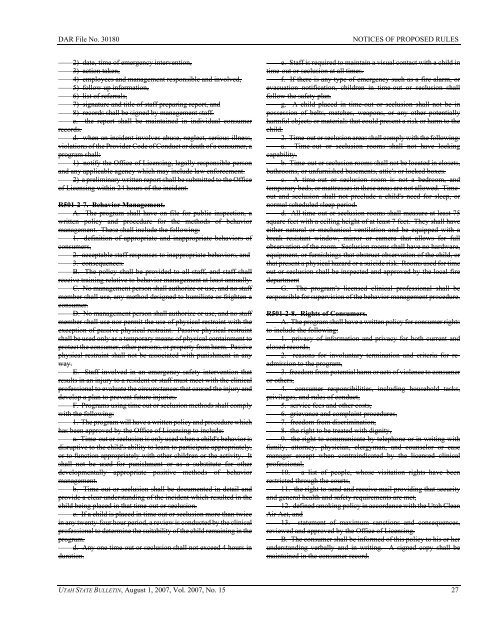
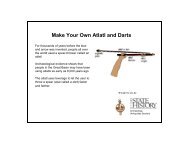

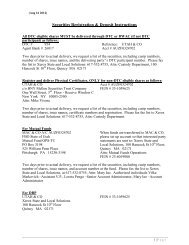
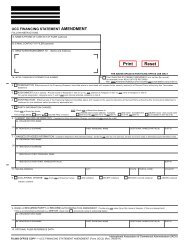
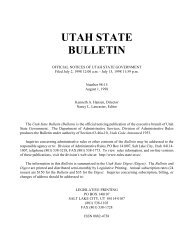
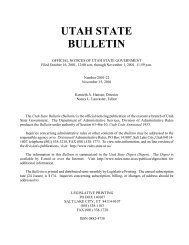

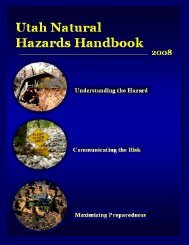

![Lynx avoidance [PDF] - Wisconsin Department of Natural Resources](https://img.yumpu.com/41279089/1/159x260/lynx-avoidance-pdf-wisconsin-department-of-natural-resources.jpg?quality=85)
